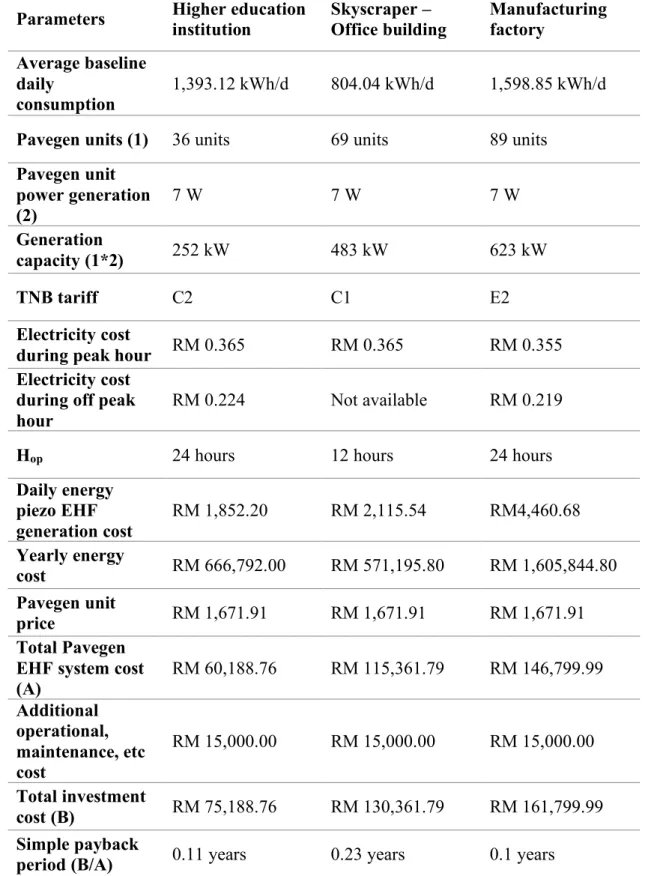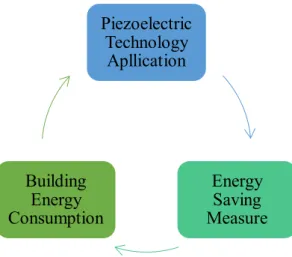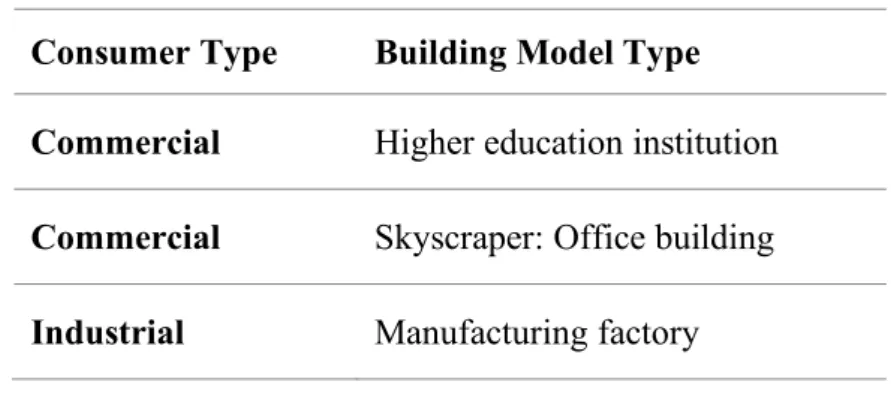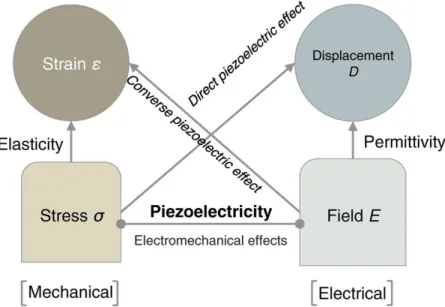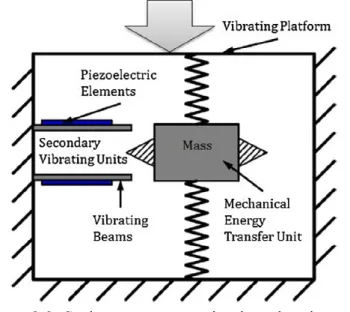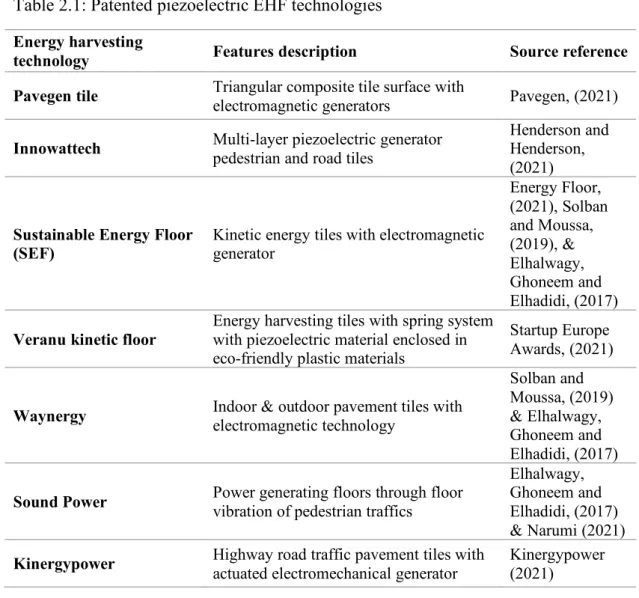Many technologies present today are based on the concept of energy harvesting together with electromechanical, electromagnetic and piezoelectric mechanisms integrated into the system. This thesis entitled "PIEZOELECTRIC ENERGY FLOOR TILES AND EFFICIENCY AS ENERGY SAVING MEASURES IN BUILDINGS FOR VARIOUS BUILDING TYPES IN MALAYSIA" was prepared by PUTERI AISYAH BINTI MEGAT SHARIFFUDIN and submitted in partial fulfillment of the requirements for the degree of Master of Engineering (Mechanical) at Universiti Tunku Abdul Rahman.
INTRODUCTION
Global Energy Issues & Scenarios: Malaysia Perspectives
One of the main greenhouse gas emissions is carbon or carbon dioxide (CO2) emissions. CO2 accounts for almost more than 70% of total greenhouse gas emissions and is largely responsible for current environmental problems, particularly climate change and air pollution.
Sustainability Through Building Energy Conservation Measures (ECMs)
In the context of RE technology implementation, it is usually categorized in the high-cost ESM category due to its typically high investment cost that usually costs more than RM for at least one small system installation. Despite the very high investment costs which are also usually associated with high risk, however, RE technologies can outperform conventional and contemporary energies in terms of costs if one considers the entire energy supply or electricity generation chain and this is also through the Stern Review reported on the Economics of Climate Change that the RE emits about 40 grams of CO2 per kilowatt-hour of electricity (kWh); conversely, a coal-based power plant emits approximately 800 to 1400g of CO2 per kWh consumed (Pelosse, 2021).
Energy Harvesting Approaches
So, with the above-mentioned idea, this study focuses on the performance of piezoelectric floor tiles as an energy harvesting system and their application as ECM for buildings in Malaysia through both enumerative and analytical studies. In the future, the term piezoelectric floor tiles in this report will be replaced by the term piezoelectric energy harvesting floor (EHF).
Research Aim and Objectives
Therefore, there is a potential for energy harvesting technology to be applied in the building industry to recover lost potential energy, which can then be returned to the building as usable electricity. To investigate and carry out technical analysis on the performance of different types of EHF piezoelectric technologies as energy harvesting mechanism for some important parameters and factors in the production and consumption of energy production.
Research Contexts, Limitation and Challenges
As for the building models' data, they are solely based on estimation and projected data from pre-audited buildings and real-time scenarios. This is because most buildings in Malaysia which are intended to be used as the models do not have a standard area intensity or base load for the same type of buildings.
Research General Framework and Methodology
In phase 2, after collecting all the primary data and information for the selected building types, a preliminary energy audit of the building is carried out to create baseline data that is used to create building models. The next step would be to create building models for different types of buildings and gather potential piezoelectric technologies to choose the implementation of building ECMs. For the construction of building models, models are developed based on two large main users, defined as commercial and industrial users.
From these two categories, only a few numbers of candidates for buildings with different typologies were selected and the list of building model types is shown in table 1.3 below.
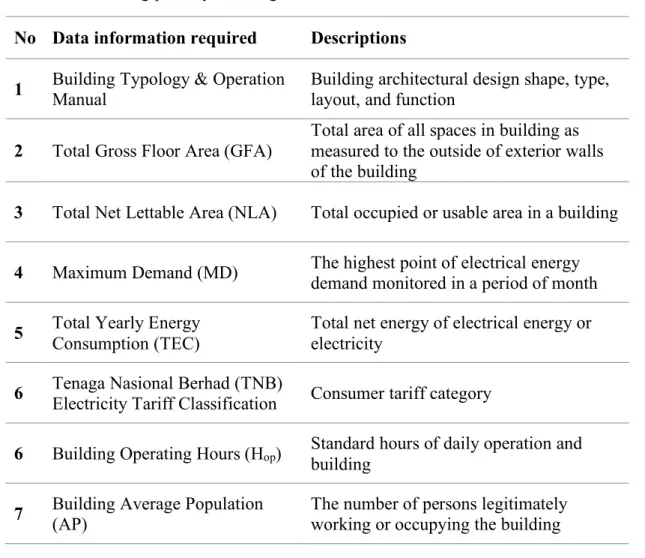
Piezoelectric Energy Harvesting System Mechanism
As a result of this introduction of the piezoelectricity, many have interpreted the piezoelectric effect as a phenomenon where the process of energy conversion takes place with the presence of external forces acting on the piezoelectric materials. Therefore, one can say that piezoelectric effect is also an electromechanical effect, and this supports the concept used in this study. So, although it is true that the piezoelectric material is the main element in the mechanism of the piezoelectric phenomenon, but many also agree that the concept of a piezoelectric effect is the phenomenon when mechanical forces act on the system by kinetic energy or vibration through a coupling method or piezoelectric transduction which then creates a deflection or displacement in the system atmosphere instead of the material itself to generate electrical charges.
Regarding piezoelectric EHF, it requires the combination of the concept of piezoelectric effect with various mechanisms via electromagnetic transducer or vibrating spring-mass mechanism in a system to convert the mechanical load exerted from human movement on the surface of a tile into electrical charges.
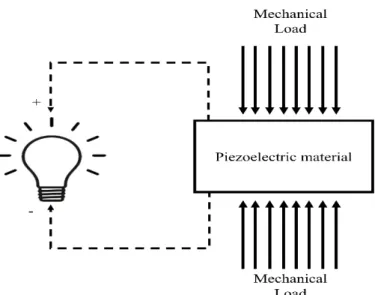
Piezoelectric Energy Harvesting Technology Application
As tabulated, each type of piezoelectric EHF technology has its own specific functions, and some of them have been implemented in real time as energy harvesting devices, especially the patented technologies. From the results, it was also reported that the most commonly used for piezoelectric material in the mechanism of the piezoelectric EHF technology is the PZT type. So, to further distinguish the real potential of the electricity generation for each other type of piezoelectric EHF technology, which is given in the previous table 2.1 and 2.2, a comparison of their respective parameter of electric energy generation is given in table 2.3.
For the self-built piezoelectric EHF system prototypes, the selected four prototypes are markedly highlighted due to their clear and unique features and characteristics, with the addition that they are from the most recent studies and specifically noted to be implemented as ' a floor tiling system in a building.
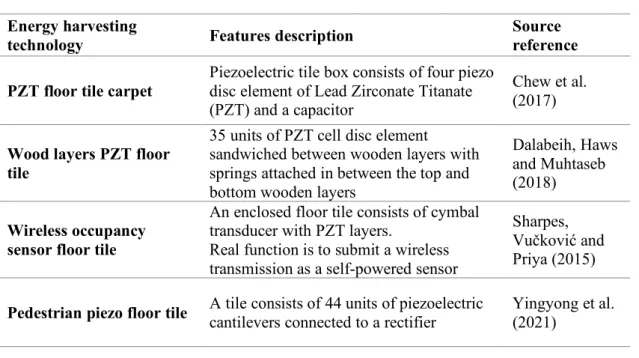
Case Studies of Piezoelectric EHF Technology Application in Building
In addition, different types of buildings with different functions can also have an impact on the overall performance of the piezoelectric EHF as evidenced in the case studies conducted by Elhalwagy, Ghoneem and Elhadidi (2017). 44 units of piezoelectric cantilevers are installed and connected in parallel within the module as the main element of the piezoelectric tile module mechanism. The overall literature review section started with an overview of the basic mechanism of the piezoelectric direct effect phenomenon in the piezoelectric EHF technology as an energy harvesting system.
Unlike the conventional application of piezoelectric, as reported in Table 2.5, most experimental prototype models lack higher electrical power generation.
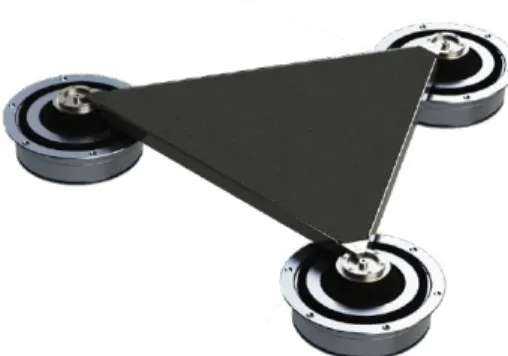
Building Preliminary Energy Audit
For the office building skyscraper, there is only one candidate for the building model in the first preliminary energy audit. However, due to the MCO situation, the building was operated at 50% of total load, so the actual data for several parameters may not be relevant. Similarly, for a manufacturing plant building, there is only one candidate for the building model in the first preliminary energy audit.
Also, due to the MCO situation, the building was not fully operational, so the actual data for several parameters may not be appropriate.
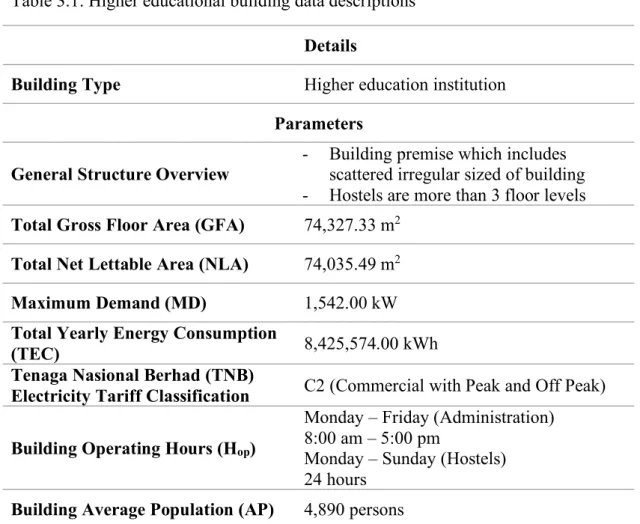
Piezoelectric EHF technology technical properties and specifications
Thus, following these findings, the main parameter considered to model the energy simulation will be the space-area dimension for the installation of the piezoelectric EHF technology. The idea is therefore to locate the available focal point within the building and measure the space area suitable to install the piezoelectric EHF technology. By measuring and determining the space area for the installation, it will also help to determine the allowable numbers of the piezoelectric EHF that can be applied and installed at the designated area.
Achieving high performance of appropriate piezoelectric EHF technology in ECM construction is an obvious goal of this paper.
Building Energy Consumption Modeling
As shown in Table 4.1, the TEC value is the baseline consumption value for a year, so the baseline consumption per day should be found by dividing the TEC by the number of operating hours as specified in Hop. So, using NLA as the main design of the size of the allowable number of applications of piezoelectric EHF technology, we could get accurate power performance. A room with one exit and one way of movement, so imagine that there is a table in the middle of the room, the transition part of the area is only through the sides of the table, which is also against the wall of the room.
Therefore, using the rule of thumb and the 1-door room concept as the main guide and reference for the assessment of the required or allowable unit quantity of piezoelectric EHF module unit that can be installed in a building accordingly.
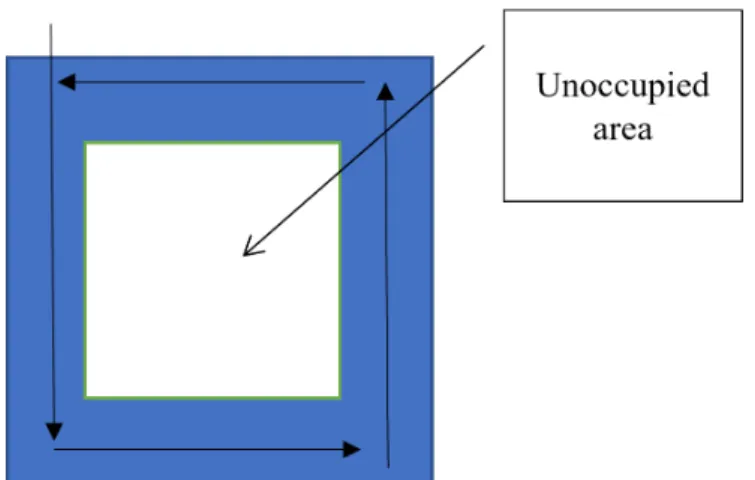
Selection of Piezoelectric EHF Technology through Technical Analysis
Other important parameters that would be considered as the eye-catching factor is the cost of the tile technology. On top of that, in the case of floor tile implementation, the material itself must be robust, have high durability and life cycle time. Although there are no studies yet that have simulated the durability and sensitivity of these piezoelectric EHF technologies, it can be concluded about how long their life cycle is.
All things considered, out of the three selected EHF technologies introduced in the previous chapters, Pavegen has taken the first place as the most preferred EHF technology that can be implemented as an ECM in a building, being a device from an established technology that has high output generation at a significantly cheap price, high durable material components, long life and easy installation method.
Energy Output Generation and Cost Analysis
Going forward, this paper succeeded in researching and technically analyzing the performance of different types of piezoelectric EHF technologies as energy harvesting mechanism for different parameters and important factors in power generation and consumption, as stated in the very first main objectives of this document. The third objective of this paper is to study and analyze the importance, compatibility and sustainability of the implementation of the mechanism to achieve an amount of at least 5% energy savings of the TEC. With the absence of this approach, it goes against one of the approaches in this paper, which is to further analyze the elements to be used in the piezoelectric EHF mechanism to generate maximum power generation in a building.
Review of piezoelectric energy harvesting system and application of optimization technique to improve harvesting system performance.
